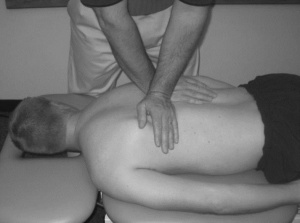Thoracic Manipulation for Shoulder Dysfunction: Difference between revisions
Maram Salem (talk | contribs) (introduction, second section with how it is formatted and worded. I also added more links within the text and additional/recent research) |
Maram Salem (talk | contribs) No edit summary |
||
| (4 intermediate revisions by 2 users not shown) | |||
| Line 1: | Line 1: | ||
{{DISPLAYTITLE:Thoracic Manipulation for Shoulder Dysfunction}} | {{DISPLAYTITLE:Thoracic Manipulation for Shoulder Dysfunction}} | ||
<div class="editorbox"> | <div class="editorbox"> | ||
'''Original Editor '''- [[User:Carla Benton|Carla Benton]] | '''Original Editor '''- [[User:Carla Benton|Carla Benton]] | ||
'''Top Contributors''' - {{Special:Contributors/{{FULLPAGENAME}}}} | '''Top Contributors''' - {{Special:Contributors/{{FULLPAGENAME}}}} | ||
</div> | </div> | ||
| Line 15: | Line 11: | ||
== Factors to Consider == | == Factors to Consider == | ||
'''Range of Motion ([https://physio-pedia.com/Range_of_Motion ROM]):''' | '''Range of Motion ([https://physio-pedia.com/Range_of_Motion ROM]):''' | ||
Generally, patients with shoulder pain present with decreased active range of motion, yielding a decrease in functional mobility and capability.<ref>MacDermid JC, Ramos J, Drosdowech D, Faber K, Patterson S. The impact of rotator cuff pathology on isometric and isokinetic strength, function, and quality of life. Journal of Shoulder and Elbow Surgery. 2004 Nov 1;13(6):593-8.</ref>Maintaining shoulder ROM is an important factor for maintaining good functional capacity and improving a patient's level of independence. | Generally, patients with shoulder pain present with decreased active range of motion, yielding a decrease in functional mobility and capability.<ref>MacDermid JC, Ramos J, Drosdowech D, Faber K, Patterson S. The impact of rotator cuff pathology on isometric and isokinetic strength, function, and quality of life. Journal of Shoulder and Elbow Surgery. 2004 Nov 1;13(6):593-8.</ref>Maintaining shoulder ROM is an important factor for maintaining good functional capacity and improving a patient's level of independence. | ||
'''Thoracic | '''Thoracic Spine:''' | ||
The shoulder, or [[Glenohumeral Joint|glenohumeral joint]], is affected by neighboring joints. It articulates with the rib cage via the scapula and is connected to the thoracic spine through various muscles. The thoracic spine forms a key link in the kinematic sequence of arm elevation. The position of the thoracic spine significantly affects scapular kinematics during scapular plane abduction. A slouched posture is associated with decreased shoulder range of motion and muscle force.<ref>Functional Anatomy of the Shoulder [Internet]. Physiopedia. Available from: <nowiki>https://www.physio-pedia.com/Functional_Anatomy_of_the_Shoulder</nowiki></ref> | The shoulder, or [[Glenohumeral Joint|glenohumeral joint]], is affected by neighboring joints. It articulates with the rib cage via the scapula and is connected to the thoracic spine through various muscles. The thoracic spine forms a key link in the kinematic sequence of arm elevation. The position of the thoracic spine significantly affects scapular kinematics during scapular plane abduction. A slouched posture is associated with decreased shoulder range of motion and muscle force.<ref>Functional Anatomy of the Shoulder [Internet]. Physiopedia. Available from: <nowiki>https://www.physio-pedia.com/Functional_Anatomy_of_the_Shoulder</nowiki></ref> | ||
| Line 27: | Line 21: | ||
Thoracic side bending and rotation are caused my unilateral humeral motions. Thoracic rotation and glenohumeral external rotation indicate significant coupling of these segmental movements. <ref>Crosbie J, Kilbreathe SL, Hooman L, York S. Scapulohumeral rhythm and associated spinal motion. Clin Biomechan. 2008; 23: 184-192.</ref> | Thoracic side bending and rotation are caused my unilateral humeral motions. Thoracic rotation and glenohumeral external rotation indicate significant coupling of these segmental movements. <ref>Crosbie J, Kilbreathe SL, Hooman L, York S. Scapulohumeral rhythm and associated spinal motion. Clin Biomechan. 2008; 23: 184-192.</ref> | ||
*Another explanation for use of | *Another explanation for use of thoracic manipulation with shoulder patients is the relationship of restoring mobility between adjacent vertebrae which may be blocked by entrapment of a meniscoid. | ||
*The relationship between reduced mobility of the cervicothoracic spine and shoulder pain could be explained by this reflexogenic mechanism. | *The relationship between reduced mobility of the cervicothoracic spine and shoulder pain could be explained by this reflexogenic mechanism. | ||
*Abnormal biomechanical relationship between adjacent vertebra can also compress nerve roots, which can affect associated segmental muscular function, such as muscle spasms. This can cause abnormal movement patterns in the shoulder complex , including the scapulohumeral joint. | *Abnormal biomechanical relationship between adjacent vertebra can also compress nerve roots, which can affect associated segmental muscular function, such as muscle spasms. This can cause abnormal movement patterns in the shoulder complex, including the scapulohumeral joint. | ||
*Use of manipulative treatment can help our patients not only improve their shoulder mobility, but improve their overall functional performance. | *Use of manipulative treatment can help our patients not only improve their shoulder mobility, but improve their overall functional performance. | ||
[[File:Chris-benson-yx-iJFybOBQ-unsplash.jpg|right|frameless]] | [[File:Chris-benson-yx-iJFybOBQ-unsplash.jpg|right|frameless]] | ||
''' | '''Postural Dysfunctions''' | ||
The [[Upper-Crossed Syndrome|upper crossed postural syndrome]] | Posture and related impairments may affect shoulder pain and the thoracic spine. The [[Upper-Crossed Syndrome|upper crossed postural syndrome]], including [[Forward Head Posture|forward head posture]], is defined by the presence of weak deep neck flexors along with weak rhomboids and lower trapezius. Tight pectoralis muscles along with a tight upper trapezius muscle can affect the position of the scapula, consequently affecting shoulder function. | ||
''' | '''Regional Interdependence''' | ||
The clinical rationale for the use of thoracic manipulation with shoulder patients is based on regional interdependence. This is defined as the 'concept that seemingly unrelated impairments in a remote anatomical region may contribute to, or be associated with, the patient's primary complaint'.<ref name=":0">Wainner RS, Whitman JM, Cleland JA, Flynn TW. Regional interdependence: a musculoskeletal examination model whose time has come. Journal of orthopaedic & sports physical therapy. 2007 Nov;37(11):658-60.</ref> Thus, thoracic spine dysfunction can affect shoulder mobility. It can create shoulder pain and limitations in function of the upper extremity. <ref name=":0" /><br> | |||
[[File:4 Prone extension-closing manipulation.jpg|right|frameless]] | [[File:4 Prone extension-closing manipulation.jpg|right|frameless]] | ||
=== | ===Body Response to Manipulation=== | ||
' | Overall, short term pain relief is observed post-spinal manipulation, reinforcing the concept of central nervous system's role in pain control.<ref>Santos-Júnior FF, Rossi DM, de Freitas LJ, Martins J, de Oliveira AS. Spinal manipulation combined with exercise therapy could be more effective than exercise therapy alone for shoulder pain and disability: A systematic review and meta-analysis. International Journal of Osteopathic Medicine. 2023 Sep 30:100688.</ref> There is also increased scapular strength with manipulation leading to overall improvement of long term strength. There is an immediate short-term reduction in the numeric pain rating score (NPRS) and shoulder pain and disability index (SPADI) score following thoracic manipulation.<ref>Rainbow DM, Weston JP, Brantingham JW, Globe G, Lee F. A Prospective Clinical Trial Comparing Chiropractic Manipulation and Exercise Therapy vs. Chiropractic Mobilization and Exercise Therapy for Treatment of Patients Suffering from Adhesive Capsulitis/Frozen Shoulder. Journal of the American Chiropractic Association. 2008 Sep 1;45(7).</ref> Postural correction in the thoracic spine decreases shoulder pain and assists with increasing overall shoulder mobility. Thoracic joint manipulation improved spinal mobility and assisted in decreasing distal and autonomic symptoms.<ref>Hegarty AK, Hsu M, Roy JS, Kardouni JR, Kutch JJ, Michener LA. Evidence for increased neuromuscular drive following spinal manipulation in individuals with subacromial pain syndrome. Clinical Biomechanics. 2021 Dec 1;90:105485.</ref> | ||
== Intervention == | |||
[[Manual Techniques for the Cervicothoracic Spine]] | |||
[[Manual Techniques for the | |||
== Case Studies == | == Case Studies == | ||
[[Effectiveness of thoracic manipulations on shoulder pain: A Case Report|The effectiveness of thoracic manipulations on shoulder pain: A Case Report]] | [[Effectiveness of thoracic manipulations on shoulder pain: A Case Report|The effectiveness of thoracic manipulations on shoulder pain: A Case Report]] | ||
== References == | == References == | ||
| Line 82: | Line 59: | ||
[[Category:Thoracic Spine - Interventions]] | [[Category:Thoracic Spine - Interventions]] | ||
[[Category:Shoulder - Interventions]] | [[Category:Shoulder - Interventions]] | ||
{{DEFAULTSORT:Thoracic_Manipulation_for_Shoulder_Dysfunction}} | |||
Latest revision as of 18:52, 17 January 2024
Original Editor - Carla Benton
Top Contributors - Kim Jackson, Maram Salem, Admin, Dana Tew, Lucinda hampton, WikiSysop and Carla Benton
Introduction[edit | edit source]
Shoulder pain is a common musculoskeletal disorder encountered in primary care.[1] For the treatment of shoulder pain, physiotherapy is recommended as an initial form of conservative treatment.[2] Of the various interventions provided, thoracic manipulation (movement of high speed and low amplitude) may be applied. The latest research demonstrates that thoracic spinal manipulation yields a decrease in shoulder pain and overall improvements in function of the shoulder.[3]
Factors to Consider[edit | edit source]
Range of Motion (ROM):
Generally, patients with shoulder pain present with decreased active range of motion, yielding a decrease in functional mobility and capability.[4]Maintaining shoulder ROM is an important factor for maintaining good functional capacity and improving a patient's level of independence.
Thoracic Spine:
The shoulder, or glenohumeral joint, is affected by neighboring joints. It articulates with the rib cage via the scapula and is connected to the thoracic spine through various muscles. The thoracic spine forms a key link in the kinematic sequence of arm elevation. The position of the thoracic spine significantly affects scapular kinematics during scapular plane abduction. A slouched posture is associated with decreased shoulder range of motion and muscle force.[5]
Thoracic side bending and rotation are caused my unilateral humeral motions. Thoracic rotation and glenohumeral external rotation indicate significant coupling of these segmental movements. [6]
- Another explanation for use of thoracic manipulation with shoulder patients is the relationship of restoring mobility between adjacent vertebrae which may be blocked by entrapment of a meniscoid.
- The relationship between reduced mobility of the cervicothoracic spine and shoulder pain could be explained by this reflexogenic mechanism.
- Abnormal biomechanical relationship between adjacent vertebra can also compress nerve roots, which can affect associated segmental muscular function, such as muscle spasms. This can cause abnormal movement patterns in the shoulder complex, including the scapulohumeral joint.
- Use of manipulative treatment can help our patients not only improve their shoulder mobility, but improve their overall functional performance.
Postural Dysfunctions
Posture and related impairments may affect shoulder pain and the thoracic spine. The upper crossed postural syndrome, including forward head posture, is defined by the presence of weak deep neck flexors along with weak rhomboids and lower trapezius. Tight pectoralis muscles along with a tight upper trapezius muscle can affect the position of the scapula, consequently affecting shoulder function.
Regional Interdependence
The clinical rationale for the use of thoracic manipulation with shoulder patients is based on regional interdependence. This is defined as the 'concept that seemingly unrelated impairments in a remote anatomical region may contribute to, or be associated with, the patient's primary complaint'.[7] Thus, thoracic spine dysfunction can affect shoulder mobility. It can create shoulder pain and limitations in function of the upper extremity. [7]
Body Response to Manipulation[edit | edit source]
Overall, short term pain relief is observed post-spinal manipulation, reinforcing the concept of central nervous system's role in pain control.[8] There is also increased scapular strength with manipulation leading to overall improvement of long term strength. There is an immediate short-term reduction in the numeric pain rating score (NPRS) and shoulder pain and disability index (SPADI) score following thoracic manipulation.[9] Postural correction in the thoracic spine decreases shoulder pain and assists with increasing overall shoulder mobility. Thoracic joint manipulation improved spinal mobility and assisted in decreasing distal and autonomic symptoms.[10]
Intervention[edit | edit source]
Manual Techniques for the Cervicothoracic Spine
Case Studies[edit | edit source]
The effectiveness of thoracic manipulations on shoulder pain: A Case Report
References[edit | edit source]
- ↑ Tekavec E, Jöud A, Rittner R, Mikoczy Z, Nordander C, Petersson IF, Englund M. Population-based consultation patterns in patients with shoulder pain diagnoses. BMC musculoskeletal disorders. 2012 Dec;13(1):1-8.
- ↑ Littlewood C, Malliaras P, Chance-Larsen K. Therapeutic exercise for rotator cuff tendinopathy: a systematic review of contextual factors and prescription parameters. International Journal of Rehabilitation Research. 2015 Jun 1;38(2):95-106.
- ↑ Haik MN, Alburquerque-Sendín F, Silva CZ, Siqueira-Junior AL, Ribeiro IL, Camargo PR. Scapular kinematics pre–and post–thoracic thrust manipulation in individuals with and without shoulder impingement symptoms: a randomized controlled study. Journal of orthopaedic & sports physical therapy. 2014 Jul;44(7):475-87.
- ↑ MacDermid JC, Ramos J, Drosdowech D, Faber K, Patterson S. The impact of rotator cuff pathology on isometric and isokinetic strength, function, and quality of life. Journal of Shoulder and Elbow Surgery. 2004 Nov 1;13(6):593-8.
- ↑ Functional Anatomy of the Shoulder [Internet]. Physiopedia. Available from: https://www.physio-pedia.com/Functional_Anatomy_of_the_Shoulder
- ↑ Crosbie J, Kilbreathe SL, Hooman L, York S. Scapulohumeral rhythm and associated spinal motion. Clin Biomechan. 2008; 23: 184-192.
- ↑ 7.0 7.1 Wainner RS, Whitman JM, Cleland JA, Flynn TW. Regional interdependence: a musculoskeletal examination model whose time has come. Journal of orthopaedic & sports physical therapy. 2007 Nov;37(11):658-60.
- ↑ Santos-Júnior FF, Rossi DM, de Freitas LJ, Martins J, de Oliveira AS. Spinal manipulation combined with exercise therapy could be more effective than exercise therapy alone for shoulder pain and disability: A systematic review and meta-analysis. International Journal of Osteopathic Medicine. 2023 Sep 30:100688.
- ↑ Rainbow DM, Weston JP, Brantingham JW, Globe G, Lee F. A Prospective Clinical Trial Comparing Chiropractic Manipulation and Exercise Therapy vs. Chiropractic Mobilization and Exercise Therapy for Treatment of Patients Suffering from Adhesive Capsulitis/Frozen Shoulder. Journal of the American Chiropractic Association. 2008 Sep 1;45(7).
- ↑ Hegarty AK, Hsu M, Roy JS, Kardouni JR, Kutch JJ, Michener LA. Evidence for increased neuromuscular drive following spinal manipulation in individuals with subacromial pain syndrome. Clinical Biomechanics. 2021 Dec 1;90:105485.









